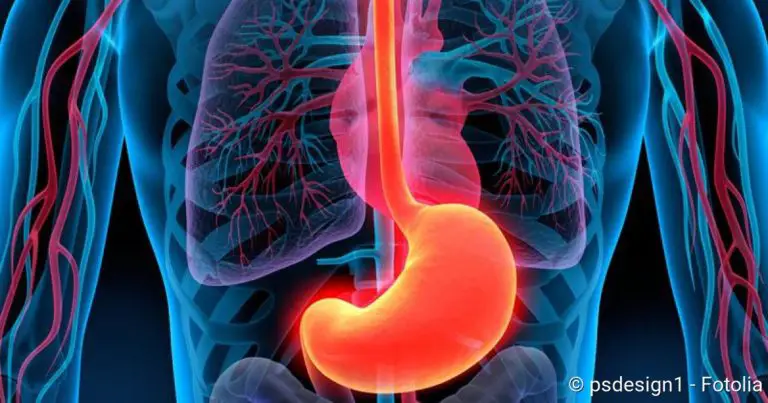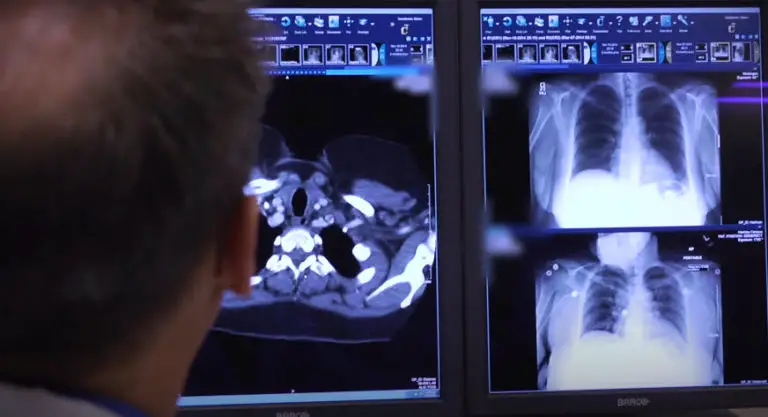Ectopic pregnancy: Description, symptoms
Ectopic pregnancy: Description, symptoms
In an ectopic pregnancy, the fertilised egg does not nestle in the uterus but in the fallopian tube. This can happen if the fallopian tube is not completely permeable. The growing embryo can cause the fallopian tube to rupture. Life threatening bleeding in the abdominal cavity is the result. Since the symptoms of an ectopic pregnancy are hardly different from those of a normal pregnancy, only a specialist can make the diagnosis. Read more about ectopic pregnancy here!

Brief overview
- What is an ectopic pregnancy? Pregnancy in which the fertilised egg is deposited in the fallopian tube instead of the uterus. Most common form of extrauterine pregnancy (pregnancy with implantation of the embryo outside the uterus).
- Causes: Non-permeable or not completely permeable fallopian tubes. Various risk factors such as stuck or kinked fallopian tubes, tubal polyps, previous tubal inflammation, previous ectopic pregnancies, abdominal or pelvic surgery, smoking, coils, fertility problems, artificial insemination, etc.
- Symptoms: Contravailing abdominal pain, bleeding from the vagina, dizziness, circulatory problems, general malaise.
- Complication: Torn fallopian tube with severe bleeding into the abdominal cavity and circulatory shock (danger to life!).
- Treatment: Depending on the stage of ectopic pregnancy. Usually surgical removal of the embryo, if possible while preserving the affected fallopian tube. In a very early stage possibly drug treatment. Sometimes also waiting under medical supervision (the embryo can spontaneously leave on its own).
- Prognosis: Complete healing with correct treatment. Later pregnancies can proceed quite normally.
Ectopic pregnancy: description and causes
At around 96 percent, tubal pregnancy (tubal pregnancy) is the most common form of so-called ectopic pregnancy (extrauterine pregnancy, EUG). This refers to pregnancies in which the fertilised egg is implanted outside the uterus (ectopic implantation). In the case of an ectopic pregnancy, the ovum becomes lodged in the fallopian tube. In other forms of ectopic pregnancy, the egg nests in the ovaries (ovarian pregnancy), in the cervix (cervical pregnancy) or in the abdominal cavity (ectopic pregnancy). It cannot be signed out.
If the fertilised egg is mistakenly lodged in the fallopian tube instead of the uterus, a risky ectopic pregnancy develops.
Extrauterine pregnancy accounts for one to two percent of all pregnancies.
Forms of ectopic pregnancy
Depending on where in the fallopian tube the ovum is implanted, physicians distinguish three forms of tubal pregnancy:
- Ampullary tubal pregnancy: The implantation takes place in the first third of the fallopian tube.
- Isthmic ectopic pregnancy: The fertilized egg nests in the last third of the fallopian tube, just before it enters the uterus.
- Interstitial/intramural pregnancy: The fertilised egg nests at the transition from the fallopian tube to the uterus.
An ectopic pregnancy cannot be carried out. Without treatment, the growing embryo can rupture the fallopian tube. This causes a life-threatening bleeding in the abdominal cavity.
Causes of an ectopic pregnancy
Normally, the fertilised egg migrates through the fallopian tube into the uterus and nests there. However, if the fallopian tube is not or only partially permeable, the egg gets stuck in it on its way into the uterus and grows solid. The patency of a fallopian tube can be impaired for various reasons. These include:
- Adhesions or kinking of the fallopian tube
- Tubal Polyps
- congenital anatomical features such as cavities in the wall of the fallopian tube
- Scars or adhesions of the rush tenant, for example due to previous operations in the abdominal or pelvic area
- previous inflammation of the fallopian tubes, especially if it was caused by chlamydia
- previous ectopic pregnancies
- Fertility disorders and artificial insemination
- local damage to the fallopian tubes, for example through endometriosis (foci of scattered uterine lining, for example in the fallopian tubes)
- Abortions
- Miscarriages
- Muscle weakness
- too few cilia on the inner wall of the fallopian tubes (the hair-thin cilia drive the egg in the fallopian tube)
- Taking the emergency contraceptive pill
- hormonal imbalance
- Tuberculosis
Smoking also promotes the development of an ectopic pregnancy. Nicotine restricts the mobility of the cilia.
Women who use a contraceptive coil also have an increased risk: the coil makes it easier for microorganisms to access the fallopian tubes, where they can cause inflammation. These in turn favour an ectopic pregnancy.
The number of ectopic pregnancies has increased in recent decades. Experts discuss various reasons for this, including increased inflammation of the fallopian tubes due to sexually transmitted diseases, more frequent fertility treatments, the use of coils as contraceptives and smoking.
Ectopic pregnancy: Recognizing symptoms
An ectopic pregnancy initially proceeds like a normal pregnancy:
- Absence of the period
- Nausea in the morning (possibly also at other times of the day)
- Feeling of tension in the breasts
Even a pregnancy test cannot distinguish between a normal and an ectopic pregnancy. It also indicates a positive result for the latter. This is because the placenta produces the pregnancy hormone beta-HCG (human chorionic gonadotropin) in an ectopic pregnancy, as in a normal pregnancy, to which the test reacts positively.
Ectopic pregnancy: Signs
The signs of an ectopic pregnancy typically appear only between the sixth and ninth week of pregnancy. They are among them:
- unusual, usually unilateral, cramp-like or contraction-like pain in the abdomen
- tense abdominal wall, which reacts sensitively to touch
- Bleeding from the vagina (often as a weak brownish discharge = spotting, but sometimes dark red with lumps of coagulated blood and/or tissue parts)
- Dizziness and pallor
- Shortness of breath
- quick pulse
- Nausea and vomiting
- general discomfort
- slightly elevated temperature
The symptoms of an ectopic pregnancy can vary from woman to woman. They can also occur suddenly and intensively or slowly increase.
The symptoms mentioned are not specific to ectopic pregnancy. Similar complaints can also occur in the case of inflammation of the renal pelvis, appendicitis, ovarian inflammation or inflammation of the fallopian tubes. Only a doctor can determine the exact cause of the symptoms.
Ectopic pregnancy: complications
Complications occur in about three out of ten women with ectopic pregnancy: The fallopian tube ruptures through the growing embryo. Important blood vessels (usually the arteria uterina or the arteria ovarica) are damaged. The consequences are severe internal bleeding. The warning signs are sudden, very severe, unilateral abdominal pain that can radiate to the upper abdomen, back and shoulders. The blood loss may cause dizziness, fainting or circulatory shock.
If there are signs of an ectopic pregnancy, you should consult a doctor immediately. If the fallopian tube is torn, life is in danger! Then alert the ambulance immediately!
Ectopic pregnancy
A very rare ectopic pregnancy, like ectopic pregnancy, is a form of ectopic pregnancy: the fertilised egg falls through the upper opening of the fallopian tube into the abdominal cavity and nests here – usually on the intestinal wall or the back wall of the uterus.
Usually an abdominal pregnancy is discovered during the preventive ultrasound examinations. The embryo in the abdominal cavity is usually not viable. In most cases it dies off by itself. If that doesn’t happen, it will be surgically removed.
You can find out more about this topic in the article on ectopic pregnancy.
Ectopic pregnancy: examinations and diagnosis
If an ectopic pregnancy is suspected, the gynaecologist (gynaecologist) will first take a medical history (anamnesis) in a conversation with the patient: he will have a detailed description of the symptoms and inquire about any risk factors (previous ectopic pregnancies, inflammation of the fallopian tubes, miscarriages or abdominal operations, endometriosis, etc.).
Gynaecological examination
This is followed by a vaginal palpation examination: the internal and external palpation is part of the normal gynaecological examination. The doctor can gain important clues from this. If an ectopic pregnancy is present, the uterus is smaller than it should be based on the current week of pregnancy. During the palpation examination, the physician may also notice that one fallopian tube is enlarged on one side.
Palpation of the fallopian tube in which the embryo is implanted may be somewhat painful.
Ultrasound
Where exactly a fertilised egg cell has implanted itself can usually be determined by means of an ultrasound examination. It can be done through the vagina (transvaginal sonography). This makes it possible to determine whether a normal pregnancy exists (i.e. with implantation in the uterine cavity). If no egg is visible in the uterus, this may be due to the following reasons:
- The embryo has settled in the uterus after all, but is still too small to be detected by ultrasound. The pregnancy is then less advanced than was assumed on the basis of the last menstrual period observed.
- Although the embryo was in the uterus, it was rejected (miscarriage, miscarriage).
- The embryo has actually implanted itself outside the uterus (extrauterine pregnancy such as ectopic pregnancy).
To examine the third possibility, the gynaecologist can use a special variant of ultrasound examination, colour Doppler sonography. It can make tissue that is particularly well supplied with blood visible – for example, the area of the mucous membrane where the egg cell has nested (such as the fallopian tube).
Blood test
In addition, the doctor can determine the amount of the pregnancy hormone Beta-HCG (human chorionic gonadotropin) in the blood of pregnant women several times over a longer period of time. In normal pregnancies the blood level of this hormone doubles every two days. If, on the other hand, the ovum has incorrectly implanted itself (as in an ectopic pregnancy), the HCG level rises only slowly, stagnates or even drops again.
Laparoscopy
In unclear cases, the doctor can also perform an additional laparoscopy. It can be determined with certainty whether an ectopic pregnancy is actually present. If so, the incorrectly implanted egg can be removed immediately during the examination (see: Treatment).
Ectopic pregnancy: treatment
Depending on how far advanced the ectopic pregnancy is, different treatment approaches are required.
Laparoscopy
If an ectopic pregnancy is associated with abdominal pain, incipient bleeding in the abdominal cavity or abnormal HCG levels, a laparoscopy must usually be performed. This allows the extrauterine pregnancy to be detected and treated at the same time. During the procedure, the doctor inserts a so-called endoscope into the abdominal cavity through three small incisions in the abdominal wall. This is a thin, flexible tube with a light source and a small camera at the tip. Using the endoscope, the doctor can insert the finest medical instruments to remove the embryo from the fallopian tube.
Open surgery
In some cases of ectopic pregnancy, open surgery (laparotomy) is necessary: the surgeon opens the abdominal wall with a larger incision to remove the embryo in the fallopian tube. Open surgery is necessary, for example, if laparoscopy is not possible for certain reasons, or if the woman has extensive adhesions or an unstable circulation. Even in cases where the ectopic pregnancy has already led to a rupture of the fallopian tubes, open surgery must be performed. This is the only way to stop the heavy bleeding as quickly as possible.
If the bleeding is very heavy or the fallopian tube is severely damaged, it sometimes has to be removed completely. However, the doctors always try to preserve the fallopian tube if it is somehow possible.
Medication
A very early ectopic pregnancy can also be treated with medication in individual cases. Pregnant women are usually given the active substance methotrexate. The treating doctor injects the cytotoxin into the amniotic cavity under ultrasound control, causing the embryo to die. In the days after, the doctor regularly checks whether the beta-HCG level in the pregnant woman’s blood is decreasing. This drop indicates that the pregnancy has actually ended.
Drug treatment is only possible under certain conditions. Thus, ectopic pregnancy must not yet cause any symptoms. In addition, the embryo together with the surrounding tissue must be smaller than four centimetres. Last but not least, the HCG level in pregnant women’s blood must be below a certain threshold.
Wait and see
Many tubal pregnancies end by themselves within the first three months of pregnancy. Since the fallopian tube does not offer enough space for the growing embryo and cannot guarantee its adequate supply, the egg cell bursts. The placenta and fruit sac then detach from the wall of the fallopian tube. They come off naturally together with the embryo.
If no symptoms occur and the level of the pregnancy hormone Beta-HCG in the blood is exceptionally low, it may be possible to wait a few days before starting therapy. The pregnant woman is carefully monitored. If the concentration of the pregnancy hormone drops further during this period and the embryo stops growing, the pregnancy is most likely terminated. However, if the embryo continues to grow, the fallopian tube can rupture within a very short time and lead to dangerous bleeding. One must be prepared for this possibility: it must be ensured that in such an emergency the pregnant woman can be operated on quickly.
Ectopic pregnancy: course and prognosis
Often an ectopic pregnancy goes unnoticed and ends by itself – the incorrectly implanted egg is rejected together with the placenta. If this does not happen, the ectopic pregnancy should be terminated as early as possible with surgery or medication.
Drug treatment is considered gentler on the affected fallopian tube than surgery, but is only possible in certain cases. If a surgical intervention (laparoscopy, open surgery) cannot be avoided, in most cases the fallopian tube can be preserved. Its patency is usually still 80 to 90 percent after the operation. The same applies, by the way, if the ectopic pregnancy is treated with medication.
depends on various factors. For example, how badly the fallopian tube has been damaged by the tubal pregnancy, whether it needs to be removed and how well the second fallopian tube works. It also has an influence whether the woman has had more than one ectopic pregnancy. That’s about right:
After a first ectopic pregnancy that has been terminated surgically (while preserving the affected fallopian tube), the risk of a second such ectopic pregnancy is about 15 percent. If a woman has already had two ectopic pregnancies, the “risk of recurrence” is about 40 percent.
In general, however, more than half of all women who have had an ectopic pregnancy (or other ectopic pregnancy) will have another child later.




